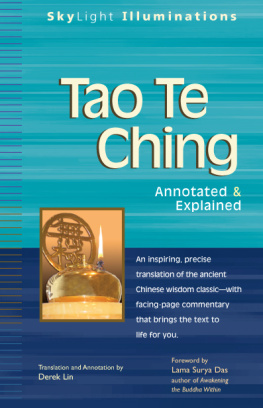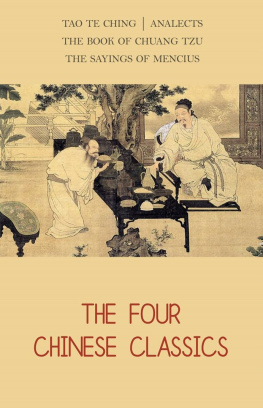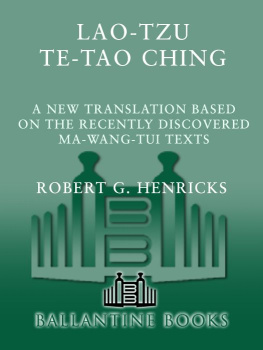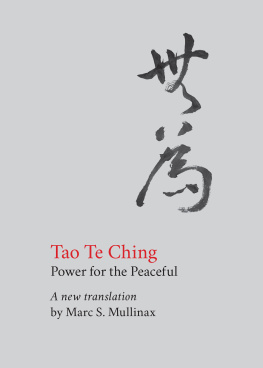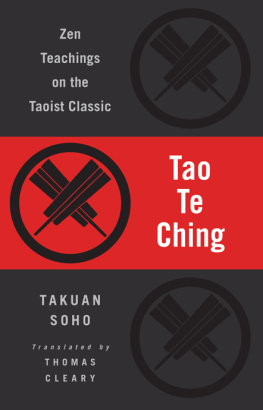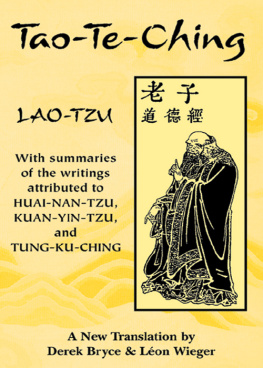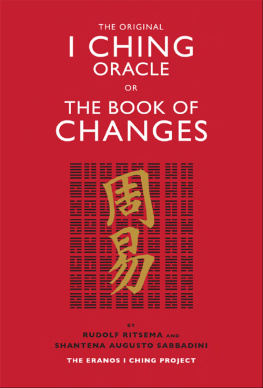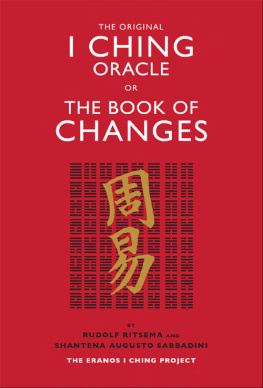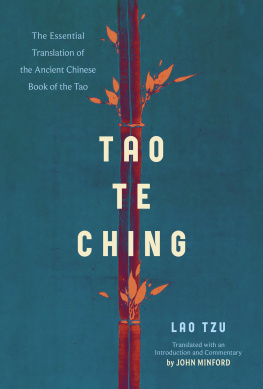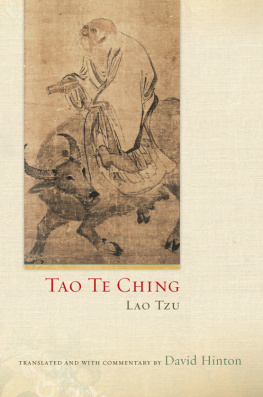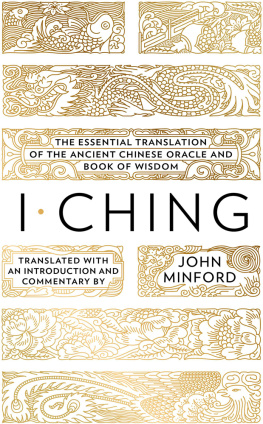
Tao Te Ching:
Annotated & Explained
2009 Quality Paperback Edition, Fourth Printing
2008 Quality Paperback Edition, Third Printing
2007 Quality Paperback Edition, Second Printing
2006 Quality Paperback Edition, First Printing
Translation, annotation, and introductory material 2006 by Derek Lin
Foreword 2006 by Lama Surya Das
All rights reserved. No part of this book may be reproduced or transmitted in any form or by any means, electronic or mechanical, including photocopying, recording, or by any information storage and retrieval system, without permission in writing from the publisher.
For information regarding permission to reprint material from this book, please mail or fax your request in writing to SkyLight Paths Publishing, Permissions Department, at the address / fax number listed below, or e-mail your request to permissions@skylightpaths.com.
Library of Congress Cataloging-in-Publication Data
Lin, Derek, 1964
Tao te ching : annotated & explained / by Derek Lin.
p. cm.
Includes bibliographical references.
ISBN-13: 978-1-59473-204-1 (quality pbk.)
ISBN-10: 1-59473-204-3 (quality pbk.)
1. Laozi. Dao de jing. 2. Laozi. 3. Taoism. I. Title.
BL1900.L35L519 2006
299.5'1482dc22
2006016008
10 9 8 7 6 5 4
Manufactured in the United States of America
Cover design: Walter C. Bumford III
Cover art: Lin Hsin Chieh
SkyLight Paths Publishing is creating a place where people of different spiritual traditions come together for challenge and inspiration, a place where we can help each other understand the mystery that lies at the heart of our existence.
SkyLight Paths sees both believers and seekers as a community that increasingly transcends traditional boundaries of religion and denominationpeople wanting to learn from each other, walking together, finding the way.
SkyLight Paths, Walking Together, Finding the Way and colophon are trademarks of LongHill Partners, Inc., registered in the U.S. Patent and Trademark Office.
Walking Together, Finding the Way
Published by SkyLight Paths Publishing
A Division of LongHill Partners, Inc.
Sunset Farm Offices, Route 4, P.O. Box 237
Woodstock, VT 05091
Tel: (802) 457-4000 Fax: (802) 457-4004
www.skylightpaths.com
Contents
Foreword
Lama Surya Das
The classic Tao Te Ching is, in my opinion, simply the wisest book ever written. I have read and reread it more than any other, and I have discovered that, unlike some of us, it only gets better and better with age. It reveals how both action and contemplation are paths to experiencing harmony, peace, and unity admidst diversity. It exemplifies both the Bodhisattvas skillful means of being there while getting there, every single step of the way, and the sublime secret that is the inseparability of oneness and noneness. It is also the ultimate primer on menschkeit, the art of living as a mature person of integrity, expounding how to be a good citizen and impeccable leader, attain genuine excellence, and realize self-mastery.
I first met the Tao Te Ching while in college in Buffalo, New York, during the tumultuous late 1960s. I was both enamored of the serene wisdom of this sublime text and mesmerized by its poetic brevity and tantalizing existential mystery. The morning after discovering the Tao Te Ching, I went straight to the bookstore and bought a copy, mulling over its cryptic verses day and night for weeks, finding it hard to go to class and endure academic lectures made pale by comparison. Over the years, some of my intrepid friends have even ventured to translate, or make versions of, the Tao Te Chinga daunting task at best. As a Buddhist teacher, I often recommend the Tao Te Ching to my Dharma students to augment their spiritual studies and refine their sense of practice, of presencing.
My oldest Chinese friend in Hong Kong, the master puppet maker and old school Shanghai Zen man we called Michael Lee, used to read me one poem every morning at dawn, upstairs in his Kowloon slum apartment. When he died, he left me a hand-calligraphed copy of one of his ancient, yellowed rice-paper manuscripts of the Chinese classic, which remains one of my prized Asian artifacts. Derek Lins fine new translation is as good as any and better than many, and his commentaries help illumine the text.
Word has it that one day some disciples found the elder Taoist philosopher Chuang Tzu in front of his house, sitting peacefully on the ground in the sun with his fresh-washed long hair cascading down around him. The students gathered around him and waited patiently. What are you doing, Master? they finally asked. Drying my hair in the sun, the old sage replied. Can we help you? they wanted to know. How can you help me; what is there that that needs to be done? My hair is being dried by the sun, and I am resting at the origin of all things.
This enigmatic story concerns the inner journey to the very center of things, beyond the dichotomy of doing and being and yet including both. The Taoist sages exemplify harmony and serenity, oneness, authenticity, and the spontaneous flow of naturalness. When nothing is done, nothing is left undone. Thats really somethin, aint it?
When I myself dont know what to do, which is surprisingly often, I try to take the Tao Te Chings advice on the subject and do nothing, along the lines of the core Taoist notion of wu wei, which can be translated as nonstriving. Overdoing things has produced so much more harm than good in this busy world; I think wed do well to learn how to undo the habit of overdoing. The nineteenth-century enlightened vagabond and Tibetan Dzogchen master Patrul Rinpoche sums it up like this: Beyond action and inaction the sublime Dharma is accomplished. This is the sublime peace of the Tao, something we can all experience by learning to live in the Tao through coming into accord with how things actually arewhat Tibetan Buddhists call the natural state. Rather than trying to build skyscrapers to reach heaven and bridges to cross the raging river of samsara to reach the so-called other shore of nirvana, we could realize that it all flows right through us right now and theres nowhere to go, nothing to get, and all is perfect as it is. This deep inner knowing has a lot to do with trust and letting be; there is nirvanic peace in things just as they are.
This should not be misconstrued as a rationalization for mere quietism, cold indifference, passivity, or dropping out. Five hundred years before Jesus, Taoists taught passive resistance, a crucial element of world-changing modern spiritual activists such as Mahatma Gandhi, Martin Luther King Jr., and the Dalai Lama of Tibet. The ancient masters revealed how to be steadfast and supple, like waterflowing rather than fixed, rigid, or staticwhich is of great benefit, for water is stronger than even stone: waters constant flow will eventually wear anything down and carry everything away. Like the underlying continuum of reality, the great Tao is groundless and boundless; it is flowing, dynamic, yet unmoved amidst infinite change. Yield and overcome, and you cannot be broken, they taught. Bend and be straight. These are powerful words, truth spoken to power. Wisdom is as wisdom does. Awakening oneself awakens the whole world.
A little Tao goes a long way. The Tao Te Ching should be savored leaf by leaf, line by line, like haiku poetryread and enjoyed, pondered, and reread again. These finely wrought, provocative, ultimate utterances are chock full of one-sentence sermons encapsulating universal wisdom in a charming, poetic form that leaves room for more interpretation than a Rorschach inkblot. Here we can find evocative pearls of wisdom concerning the mysteries of yin and yang and the manner in which the great Middle Way balances, harmonizes, and reconciles primordial dichotomies such as light and dark, heaven and earth, good and evil, man and woman, doing and being, life and death. These sublime little sutras have edified, instructed, encouraged, and entertained millions of people for millennia, and they continue to do so today. Like a veritable treasure trove, this masterful book of wise living and authentic being provides both spiritual sustenance and practical guidance, so necessary for us today and tomorrow.
Next page
